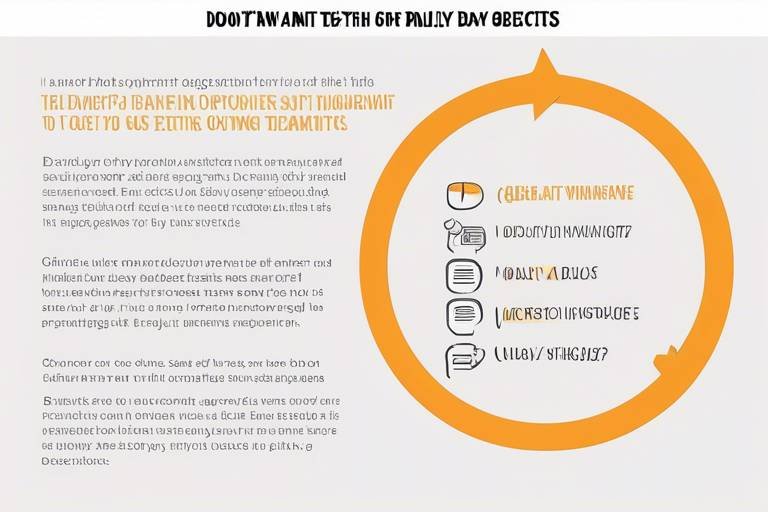How to Use Time Blocking for Effective Scheduling
Time blocking is a powerful productivity technique that can revolutionize the way you manage your time. By allocating specific time slots to different tasks, you can enhance your focus, prioritize effectively, and accomplish more in your day. Imagine your schedule as a puzzle, with each time block fitting perfectly into place, creating a seamless flow of productivity.
When you understand the concept of time blocking, you unlock a world of possibilities for optimizing your daily routine. It's like having a personal time management assistant guiding you through your day, ensuring that every minute is utilized efficiently. With time blocking, you take control of your schedule rather than letting it control you.
One of the key benefits of time blocking is the increased productivity it brings. By dedicating specific time slots to tasks, you eliminate the temptation to multitask and scatter your focus. Instead, you immerse yourself fully in one task at a time, leading to higher quality work and faster completion times.
Implementing time blocking techniques requires a strategic approach. Setting realistic goals for each time block is essential to avoid feeling overwhelmed or falling behind schedule. Think of time blocking as a roadmap for your day, guiding you from one task to the next with precision and clarity.
To enhance your time blocking experience, consider using tools and apps designed to streamline the process. Digital calendars, task management software, and specialized time blocking apps can help you organize your schedule, set reminders, and track your progress effectively.
Optimizing your time blocking schedule involves regular review and adjustment. Just as a gardener tends to their plants, you must nurture and refine your time blocking routine to ensure maximum efficiency. Remember to include breaks in your schedule to recharge and maintain focus throughout the day.
Avoiding common time blocking mistakes is crucial for success. Over-scheduling can lead to burnout, while neglecting buffer time can derail your entire schedule. By learning from these pitfalls, you can fine-tune your time blocking approach and achieve optimal results.
By combining time blocking with other productivity techniques, such as the Pomodoro Technique or the Eisenhower Matrix, you can supercharge your efficiency levels. Each method complements the other, creating a synergy that propels you towards your goals with precision and purpose.
Adapting time blocking to your unique needs is the final step in mastering this technique. Just as a tailor customizes a suit to fit perfectly, you can tailor your time blocking strategy to suit your work style, preferences, and objectives. Embrace the flexibility of time blocking and watch as your productivity soars to new heights.

Understanding Time Blocking
Time blocking is a productivity technique where you allocate specific time slots to different tasks. Learn how to implement this method for better time management and increased focus in your daily schedule.
Understanding time blocking is essential for mastering your schedule. It involves dividing your day into specific blocks of time dedicated to particular tasks or activities. By focusing on one task at a time, you can enhance your concentration and productivity. Imagine your day as a puzzle, with each block of time fitting perfectly to create a complete picture of efficiency.
Time blocking helps you prioritize tasks effectively, reduce distractions, and improve your overall efficiency. By assigning dedicated time slots to important activities, you ensure that they receive the attention they deserve. It's like creating a roadmap for your day, guiding you through each task with clarity and purpose.
Moreover, time blocking allows you to visualize your day in a structured manner, making it easier to manage your time effectively. It's like organizing your closet, where each item has its designated place, leading to a clutter-free and organized space. Similarly, time blocking creates a sense of order in your schedule, reducing the chaos and increasing your productivity.
By understanding the concept of time blocking, you can take control of your day and make the most of every minute. It's a powerful tool that empowers you to manage your time efficiently and achieve your goals with precision.

Benefits of Time Blocking
Time blocking offers a plethora of benefits that can revolutionize the way you manage your time and boost your productivity. By allocating specific time slots to tasks, you can experience a significant improvement in your daily routine.
One of the key advantages of time blocking is increased productivity. When you dedicate focused time to a particular task without distractions, you are likely to accomplish more in less time. This focused approach allows you to delve deep into a task, leading to higher quality output.
Furthermore, time blocking enhances time management skills. By planning your day in advance and assigning specific time slots to each activity, you gain better control over your schedule. This structured approach helps in prioritizing tasks and ensures that important activities are not overlooked.
Reduced stress levels are another notable benefit of time blocking. By breaking down your day into manageable chunks of time dedicated to specific tasks, you can avoid the overwhelming feeling of having too much to do at once. This method promotes a sense of accomplishment as you complete each task within its allocated time frame.
Moreover, time blocking encourages improved focus and concentration. By eliminating multitasking and honing in on one task at a time, you can fully engage with the work at hand. This heightened focus leads to increased efficiency and better results.
In addition, time blocking allows for better work-life balance. By setting aside specific time slots for work, personal activities, and relaxation, you can ensure that all aspects of your life receive the attention they deserve. This balance contributes to overall well-being and satisfaction.

Implementing Time Blocking Techniques
Implementing Time Blocking Techniques involves a strategic approach to managing your time effectively. One key strategy is to set realistic goals for each time block, ensuring that tasks are achievable within the allocated time frame. By breaking down your day into focused intervals, you can maintain a structured schedule and stay on track with your priorities.
Creating a structured schedule is another essential technique in time blocking. Designate specific time slots for different types of tasks, such as work projects, personal errands, and relaxation. This helps you maintain a balance between productivity and self-care, ensuring that all aspects of your life receive adequate attention.
Dealing with unexpected interruptions is a common challenge when implementing time blocking. It's important to establish boundaries and communicate your time blocks to others, reducing the likelihood of disruptions. Additionally, having buffer time between tasks allows for flexibility and helps accommodate unforeseen events without derailing your entire schedule.
Utilizing digital tools and apps can enhance the effectiveness of your time blocking techniques. Digital calendars, task management software, and specialized time blocking apps can provide visual cues, reminders, and tracking features to keep you organized and focused throughout the day. Experiment with different tools to find the ones that best suit your workflow and preferences.
Consistency is key when implementing time blocking techniques. Reviewing and adjusting your plan regularly ensures that you are optimizing your schedule for maximum productivity. It's also important to set aside dedicated time for breaks to recharge and prevent burnout, maintaining a healthy work-life balance.

Tools for Time Blocking
When it comes to implementing time blocking effectively, having the right tools at your disposal can make a significant difference in how smoothly the process runs. Utilizing various tools and apps can streamline your time management efforts and enhance your productivity levels. Let's explore some of the essential tools for time blocking that you can incorporate into your daily routine.
One of the most popular tools for time blocking is digital calendars. Platforms like Google Calendar, Outlook Calendar, or Apple Calendar allow you to create detailed schedules, set reminders, and color-code tasks for better organization. By utilizing digital calendars, you can easily visualize your time blocks and ensure that you stay on track with your daily agenda.
Task management software is another valuable tool for effective time blocking. Applications like Trello, Asana, or Todoist enable you to create task lists, set deadlines, and track your progress on various projects. These tools can help you break down tasks into smaller subtasks, allocate specific time blocks for each activity, and monitor your overall productivity levels.
Specialized time blocking apps are designed specifically to assist users in implementing this productivity technique. Apps like Focus Booster, Clockify, or TimeTune offer features such as timer-based scheduling, customizable time blocks, and detailed analytics on how you spend your time. By using these apps, you can enhance your time management skills and optimize your daily schedule for maximum efficiency.

Optimizing Your Time Blocking Schedule
Optimizing your time blocking schedule is crucial for ensuring maximum efficiency and productivity in your daily routine. One key tip for optimizing your time blocking schedule is to regularly review and adjust your plan. By assessing what tasks were completed as planned and what areas need improvement, you can refine your time blocking strategy for better results.
Another important aspect of optimizing your time blocking schedule is to set aside dedicated time for breaks. While it may seem counterintuitive to schedule breaks, regular intervals of rest can actually enhance your focus and overall productivity. By incorporating short breaks into your time blocking schedule, you can recharge and tackle tasks with renewed energy.
Maintaining flexibility is also essential when optimizing your time blocking schedule. Unexpected interruptions or changes in priorities are bound to occur, so it's important to adapt your schedule accordingly. By allowing for some flexibility in your time blocking plan, you can better handle unforeseen circumstances without feeling overwhelmed.
Moreover, consider incorporating buffer time into your time blocking schedule. Buffer time acts as a cushion between tasks, allowing for unexpected delays or additional time needed to complete a task. By including buffer time in your schedule, you can avoid feeling rushed and ensure a more realistic allocation of time for each activity.

Avoiding Common Time Blocking Mistakes
Avoiding Common Time Blocking Mistakes is crucial for ensuring the effectiveness of this productivity technique. One common mistake to steer clear of is over-scheduling your time blocks. It's essential to allocate realistic time frames for each task to prevent feeling overwhelmed and unable to complete your schedule.
Another mistake to avoid is failing to account for buffer time between tasks. Unexpected interruptions or tasks taking longer than expected can throw off your entire schedule if you don't leave room for flexibility. Including buffer time in your time blocking plan can help you stay on track even when things don't go as planned.
Furthermore, neglecting to prioritize tasks properly can lead to inefficiencies in your time blocking schedule. It's important to identify the most important tasks that need to be completed and allocate sufficient time for them. Without clear prioritization, you may find yourself spending too much time on less important activities, impacting your overall productivity.

Combining Time Blocking with Other Productivity Techniques
When it comes to maximizing your productivity, combining time blocking with other proven techniques can take your efficiency to the next level. One powerful method to complement time blocking is the Pomodoro Technique, which involves working in focused intervals followed by short breaks. By integrating these two strategies, you can maintain high levels of concentration during your designated time blocks and recharge during the break periods.
Another valuable approach that pairs well with time blocking is the Eisenhower Matrix, a framework for prioritizing tasks based on urgency and importance. By using this method in conjunction with time blocking, you can ensure that you are dedicating your scheduled time to the most critical and impactful activities, leading to a more effective use of your day.
Furthermore, incorporating goal setting into your time blocking routine can provide a clear direction for your tasks. By defining specific objectives and aligning them with your time blocks, you can track your progress, stay motivated, and ensure that your time is dedicated to activities that align with your overarching goals.
By combining these productivity techniques with time blocking, you create a comprehensive system that not only structures your day but also enhances your focus, prioritization, and goal achievement. Experiment with different combinations to find the approach that works best for your unique working style and objectives.

Adapting Time Blocking to Your Unique Needs
Adapting time blocking to your unique needs is essential for maximizing its effectiveness in managing your time efficiently. Just like a tailor customizes a suit to fit perfectly, you can tailor your time blocking approach to suit your individual preferences, work style, and specific goals. By personalizing this technique, you can ensure that it aligns with your unique requirements and helps you achieve optimal productivity.
One way to adapt time blocking to your needs is by identifying your peak productivity hours. Are you a morning person who thrives in the early hours, or do you find yourself most productive in the afternoon or evening? By scheduling your most important tasks during your peak hours, you can make the most of your energy and focus, maximizing the effectiveness of your time blocking strategy.
Another aspect to consider when customizing time blocking is your preferred work environment. Some people work best in a quiet space free from distractions, while others thrive in a bustling coffee shop atmosphere. By understanding where and when you work best, you can tailor your time blocking schedule to optimize your productivity and focus.
Additionally, consider your personal preferences and habits when adapting time blocking to your needs. Do you prefer to work on similar tasks back-to-back, or do you thrive on variety throughout the day? By structuring your time blocking schedule to accommodate your preferences, you can ensure that it is sustainable and enjoyable, making it more likely that you will stick to the plan.
Furthermore, don't be afraid to experiment and make adjustments to your time blocking approach as needed. Your unique needs and circumstances may change over time, so it's important to regularly review and refine your time blocking schedule to ensure it continues to serve you effectively. Flexibility and adaptability are key to successfully integrating time blocking into your daily routine.
Frequently Asked Questions
- What is time blocking?
Time blocking is a productivity technique where you allocate specific time slots to different tasks. By scheduling your day into dedicated blocks of time for various activities, you can focus better, prioritize tasks efficiently, and manage your time effectively.
- How can time blocking benefit me?
Time blocking offers several benefits, including increased productivity, better time management, reduced stress levels, improved focus, and enhanced efficiency in completing tasks. It helps you stay organized, prioritize important activities, and maintain a structured approach to your daily schedule.
- What are some common mistakes to avoid when using time blocking?
Common mistakes to avoid when implementing time blocking include over-scheduling tasks, neglecting to include buffer time for unexpected interruptions, and failing to prioritize activities effectively. It's important to review and adjust your time blocking schedule regularly to ensure optimal productivity.
- How can I adapt time blocking to suit my unique needs?
You can adapt time blocking to your individual preferences by customizing your schedule based on your work style, personal goals, and specific requirements. Experiment with different time blocking techniques, tools, and strategies to find what works best for you and helps you maximize your time management skills.



















